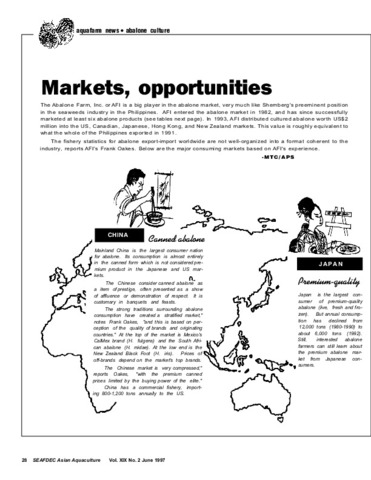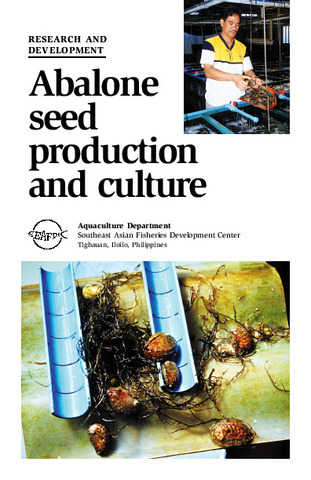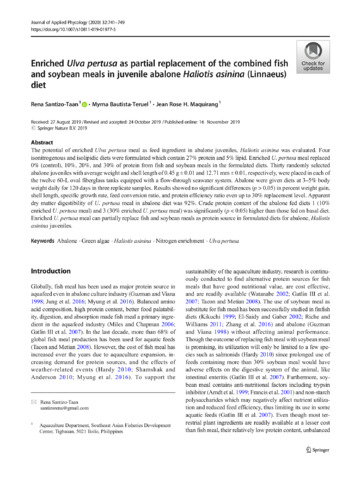First histopathological description of parasites and shell conditions of the donkey's ear abalone Haliotis asinina (Linnaeus, 1758) cultured in marine cages and land-based tanks in the Philippines
| dc.contributor.author | Erazo-Pagador, Gregoria | |
| dc.contributor.author | Pakingking, Rolando V., Jr. | |
| dc.contributor.author | Dumaran-Paciente, Haydee Rose | |
| dc.date.accessioned | 2021-02-05T05:18:44Z | |
| dc.date.available | 2021-02-05T05:18:44Z | |
| dc.date.issued | 2020-08-26 | |
| dc.identifier.citation | Erazo-Pagador, G., Pakingking Jr., R. V., & Dumaran-Paciente, H. R. (2020). First histopathological description of parasites and shell conditions of the donkey’s ear abalone Haliotis asinina (Linnaeus, 1758) cultured in marine cages and land-based tanks in the Philippines. Journal of Shellfish Research, 39(2), 375–379. | en |
| dc.identifier.issn | 0730-8000 | |
| dc.identifier.uri | http://hdl.handle.net/10862/6029 | |
| dc.description.abstract | This study is the first attempt to assess parasitic infestations in grow-out cage culture and land-based grow-out tanks of the donkey's ear abalone Haliotis asinina in the Philippines. This histopathological study of the parasites was conducted from 2010 to 2013. Using 30 samples of abalones collected monthly from two sites, samples were measured and fixed in 10% formaldehyde in seawater, and routine histological techniques were used to identify the parasites. Water temperatures of the grow-out floating sea cages and the abalone hatchery facilities whose abalones were collected measured 27.5°C–32.5°C and 26°C–29°C, respectively; salinity in the area of the sea cages was 32–34 ppt, whereas salinity of the abalone hatchery was 32–35 ppt. Examination of the shell from cage-cultured abalones revealed the presence of burrowing polychaetes belonging to the families Serpulidae (prevalence, 32.5%) and Dorvilleidae (prevalence, 30%); on the other hand, only Dorvilleidae (prevalence of 28.5%) was detected in abalones from the hatchery. Histological examination revealed the presence of unknown ciliates (prevalence, 37.5%), Nematopsis sp. (prevalence, 17%), and metacestode Tylocephalum sp. (prevalence, 8.5%) from the grow-out cage-cultured abalones, whereas unidentified ciliates (prevalence, 32.5%) and Nematopsis sp. (prevalence, 10.5%) were detected from hatchery stock. The data collected showed that there was low-intensity infection and prevalence of parasites in abalones from grow-out cages and hatchery. These records of parasites constitute baseline information for future research work on abalones. | en |
| dc.description.sponsorship | The authors thank the Government of Japan Trust Fund [GoJ-TF5 (FH-06-M10T/8400-T-RD-FH0610] for funding this work. We are grateful to Dr. Evelyn Grace de Jesus-Ayson and Ms. Milagros Castaños for their valuable comments on the manuscript and to Ms. Fely Torreta who assisted in the processing of samples. | en |
| dc.language.iso | en | en |
| dc.publisher | National Shellfisheries Association | en |
| dc.subject | Haliotis asinina | en |
| dc.subject | abalones | en |
| dc.title | First histopathological description of parasites and shell conditions of the donkey's ear abalone Haliotis asinina (Linnaeus, 1758) cultured in marine cages and land-based tanks in the Philippines | en |
| dc.type | Article | en |
| dc.identifier.doi | 10.2983/035.039.0219 | |
| dc.citation.volume | 39 | |
| dc.citation.issue | 2 | |
| dc.citation.spage | 375 | |
| dc.citation.epage | 379 | |
| dc.citation.journalTitle | Journal of Shellfish Research | en |
| dc.subject.asfa | parasites | en |
| dc.subject.asfa | histopathology | en |
| dc.subject.asfa | abalone culture | en |
| dc.subject.asfa | shells | en |
| dc.subject.asfa | aquaculture | en |
| dc.subject.scientificName | Dorvilleidae | en |
| dc.subject.scientificName | Serpulidae | en |
| dc.subject.scientificName | Nematopsis | en |
| dc.subject.scientificName | Tylocephalum | en |
Files in this item
| Files | ขนาด | รูป | View |
|---|---|---|---|
|
There are no files associated with this item. |
|||
รายการนี้ปรากฏใน (s)
-
Journal Articles [1258]
These papers were contributed by Department staff to various national and international journals.



